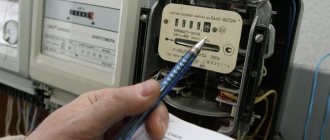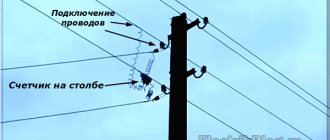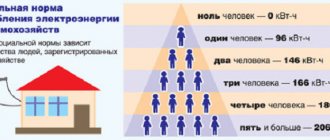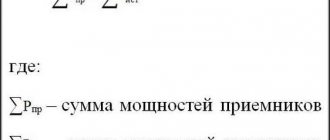Calculation of unmetered (unaccounted) electricity consumption for organizations
Recently, the number of legal disputes between consumers and network or energy sales companies over acts of unmetered electricity consumption has increased.
In this case, the consumer faces a very large financial responsibility in the form of a “fine” for unaccounted consumption of electrical energy. Therefore, consumers must clearly understand the legislative features of calculating and determining the extent of their responsibility when identifying non-accounting.
According to Government Decree No. 442 of 04.05.2012 (hereinafter referred to as the Resolution), unmetered consumption is defined as “consumption of electrical energy in violation of the energy supply agreement established (purchase and sale (supply) of electrical energy (power), contract for the provision of services for the transmission of electrical energy) and this a document on the procedure for metering electrical energy on the part of the consumer (buyer), expressed in interference with the operation of the metering device (metering system), the responsibility for ensuring the integrity and safety of which is assigned to the consumer (buyer), including violation (damage) of seals and (or) visual control signs applied to the metering device (metering system), in failure to comply with the deadlines established by the contract for notification of the loss (malfunction) of the metering device (metering system), as well as in the commission by the consumer (buyer) of other actions (inactions) that led to distortion of data on the volume of electrical energy (power) consumption.”
Important! For categories of consumers equal to the population, from July 1, 2022, a different payment procedure will apply.
How to calculate unmetered electricity consumption for SNT, see here
In case of detection of unaccounted consumption from a consumer who does not belong to the category “equal to the population”, the following provisions of the Government of the Russian Federation No. 442 apply for calculating the volume:
- Clause 195 of Resolution 442. The volume of unmetered consumption of electrical energy is determined using the calculation method provided for in subparagraph “a” of paragraph 1 of Appendix No. 3 to the Resolution.
At the same time, in relation to the consumer, when making payments for electrical energy with whom the power rate is used, in addition to the volume of unaccounted consumption of electrical energy, the amount of power purchased under an agreement ensuring the sale of electrical energy (power) and the amount of power paid in terms of services are also determined for the transmission of electrical energy, based on the hourly volumes of electrical energy consumption, determined in accordance with subparagraph “b” of paragraph 1 of Appendix No. 3 to the Resolution.
The volume of unaccounted consumption of electrical energy (power) is determined from the date of the previous control check of the metering device (if such a check was not carried out within the planned time frame, then it is determined from the date no later than which it should have been carried out in accordance with this document) to the date identifying the fact of unaccounted consumption of electrical energy (power) and drawing up a report on unaccounted consumption of electrical energy...
2. Subparagraph “a” of paragraph 1 of the appendix to Resolution 442. The volume of electrical energy (power) consumption at the corresponding delivery point, MWh, is determined:
2.1. If the contract providing for the sale of electrical energy (power) on the retail market contains data on the maximum power of energy receiving devices at the corresponding point of delivery according to the formula:
WAYS TO SAVE MONEY ON ENERGY RESOURCES
Reducing energy costs is one of the main goals of every enterprise. The importance and urgency of resolving this issue is also due to the problem of the constant increase in prices for electrical and thermal energy.
There are two ways to reduce an enterprise’s spending on energy resources (see diagram):
1) saving energy resources:
- regular energy audits at the enterprise (allows us to identify unproductive losses of energy resources);
- effective insulation of heating networks and buildings;
- use of energy saving technologies;
- selection of equipment taking into account the energy consumption class;
- saving energy consumption through rational use of electric lighting devices, etc.;
2) optimization of payments for energy resources . For example, reaching an agreement with energy suppliers on the maximum possible deferment of payments for energy resources will give the enterprise the opportunity to use funds more rationally by timely directing them to the most urgent needs. Maintaining operational contractual records under energy supply contracts and accumulating funds in advance in a current account for timely payment of utility bills will allow you to avoid various penalties for late payments.
No less important is the work of selecting suppliers among competing energy supply organizations (taking into account the terms of contracts, pricing principles, reliability and tariff levels). When choosing the work schedule of an enterprise that carries out payments in 2–6 categories, you need to take into account the dynamics of changes in electricity tariffs during the day in order to avoid the highest load of equipment falling into the most expensive hours and zones of the day.
Of no small importance is the correct choice of the price category for payment of electrical energy in accordance with production plans, schedules of technological processes and equipment operation.
Notes
- The need to select a price category in order to save electricity is due to the fact that price rates (tariffs) for electrical energy (power) and their composition for different price categories differ, and hourly tariffs of 3–6 categories vary depending on the zones of the day and peak loads on energy system.
- Each enterprise can choose the price category whose cost of electricity, when calculated, will be the lowest for it, taking into account the characteristics of the technological production process.
- Having done all the work necessary to optimize payments, any enterprise will be able to realize savings and reduce the amount of payments for energy resources.
One of the factors influencing the cost of electricity consumed and paid for by enterprises is the price category chosen by the enterprise for calculating the cost of consumed electrical energy (power), which determines the size of rates and the composition of electricity tariffs presented by suppliers.
The optimal choice of price category in accordance with production plans, work schedules, shift patterns, features of equipment and its operation, production technology will allow enterprises to significantly save on such an expense item as electricity . However, in many enterprises the price category is chosen thoughtlessly, without any economic justification.
The main reason for this situation is that calculating the cost of electricity for each price category is cumbersome and can take a lot of time. Often, energy workers and enterprise economists do not even know which price category is used for calculations, since the price category was determined by the supplier of last resort due to the fact that no notification about the choice of the enterprise was sent to it.
As a result of the lack of economic justification for the correct choice, enterprises often overpay for electricity. What can you do to avoid making a mistake in choosing the price category for paying for electricity? First, you should first calculate the cost of electrical energy ( power ) for different price categories and select the most economical option for the enterprise . And regularly determine the economic efficiency of the choice made relative to other price categories, since enterprises may change the range of products, production technologies, equipment fleet, etc. Tariffs of guaranteeing suppliers are also increasing.
W = P max x T
Where:
Pmax is the maximum power of energy receiving devices related to the corresponding point of delivery, and if the agreement ensuring the sale of electrical energy (power) on the retail market does not provide for the distribution of maximum power among delivery points, then for the purpose of applying this formula the maximum power of energy receiving devices devices within the balance sheet are distributed among delivery points in proportion to the permissible long-term current load of the corresponding input wire (cable), MW;
T - the number of hours in the billing period, when determining the volume of electrical energy (power) consumption for which, in accordance with paragraphs 166, 178, 179 and 181 of the Decree, calculation methods are subject to application, or the number of hours in the time period determined in accordance with paragraph 195 of the Decree , during which there was unaccounted consumption of electrical energy, but not more than 4,380 hours, h ;
Important: from July 1, 2022, changes have been made to the procedure for calculating the volume of unmetered electricity consumption.
Until July 1, 2022, the maximum period for which unmetered electricity consumption could be calculated is no more than 12 months (equivalent to 8760 hours)
Now the maximum period for which unmetered electricity consumption can be calculated is no more than 6 months (equivalent to 4380 hours).
At the same time, the number of hours in a day for calculating unmetered energy consumption is assumed to be 24 hours a day, regardless of the presence or absence of the number of hours agreed in the contract or the subscriber’s operating mode.
Read about other changes in unmetered electricity consumption in 2022 here.
2.2. If the agreement providing for the sale of electrical energy (power) on the retail market does not contain data on the maximum power of energy receiving devices, or if, when identifying unmetered consumption, it was revealed that the consumer is using power the value of which exceeds the maximum power of the consumer’s energy receiving devices specified in the agreement providing sale of electrical energy (power) on the retail market, according to the formulas:
for single-phase input:
,
,
Where:
Iadd.dl. — permissible long-term current load of the input wire (cable), A;
Uf.nom. — rated phase voltage, kV;
cos is the power factor at maximum load. If there is no data in the contract, the coefficient is assumed to be 0.9.
In the vast majority of identified cases of unmetered consumption, the power of energy receiving devices is assumed to be equal to the maximum power specified in the power supply contract.
Thus, when unmetered consumption of electrical energy is detected by the consumer, the above calculation method begins to be applied.
For consumers, unmetered electricity consumption carries serious financial liability.
Using this method is a severe penalty for the consumer.
In some cases, this is indicated in court decisions: “The calculation of the volume of electricity under the act of unaccounted for consumption was adopted in pursuance of Law No. 261-FZ and is in the nature of a sanction for failure to comply with the obligation to ensure proper metering of electricity” (No. A40-3007/18-72-23 , considered on April 19, 2018 in the Moscow Arbitration Court).
Here is an excerpt from the ruling of the arbitration court in case No. A10-4223/2013: “In accordance with clause 9.6 of the contract, the volume of unmetered consumption of electrical energy (power) is determined by calculation method in accordance with current legislation from the date of the previous control check of metering devices until the date of detection of the fact of unmetered consumption of electrical energy (power) and drawing up a report on unaccounted consumption of electrical energy.”
Methodology for calculating the price of electricity for the 5th and 6th price categories
When choosing the 5th and 6th price categories, the consumer must plan his own consumption 2 days in advance and transfer it to the guaranteeing supplier. The price of purchasing electricity from the supplier depends on the accuracy of consumption planning.
The price of electricity purchased from the supplier will consist of three values:
- Electricity purchased in accordance with the plan;
- Electricity purchased above the plan;
- Electricity predicted, but not purchased;
At each hour of the month, the price for 3 types of electricity will be different.
Electricity transmission service will be considered:
- For calculations for the 5th price category, the same as for calculations for the 3rd price category;
- For calculations for the 6th price category, the same as for calculations for the 4th price category;
In practice, consumers rarely use the 5th and 6th price categories for several reasons:
- The need to plan your own electricity consumption. The enterprise must organize consumption planning - this requires a lot of labor on the part of the technical service of the enterprise. Some types of production cannot adequately plan consumption due to the large number of unrelated technical processes in the enterprise.
- Small difference in electricity price with ideal planning. With ideal planning, you can additionally save up to 0.02 rubles/kW. But you can also increase the purchase price of electricity. The possible economic effect does not cover the risks of increasing prices and labor costs of the technical service.
An example of calculating unaccounted for (unaccounted for) electricity consumption for a legal entity
In order to clearly demonstrate the procedure for calculating the volume of electrical energy, when identifying unmetered consumption, we will take specific data.
The consumer was inspected on May 30, 2022. According to the results, “connection of the wire and load to the metering device” was revealed.
The Act on the instrumental verification of metering devices, on the basis of which the act on unmetered consumption was drawn up, states that the energy receiving device, in respect of which the act on unmetered consumption was drawn up, is connected to the current-carrying busbars with a PV-3 wire with a cross-section of 10 mm2. to the meter.
In this case, the calculation of unmetered electricity consumption is made based on the cross-section of the wire connected to the meter, or more precisely, based on its maximum throughput.
The maximum permissible continuous current of the specified wire is 80A. The phase voltage is 220V, the number of days of unmetered consumption is 8040 (i.e. the previous instrumental check, or the installation of a meter was completed 335 days ago).
It should be noted here that, according to paragraph 172 of the Resolution, instrumental testing of metering devices must be carried out at least once a year. Typically, network organizations are limited to this frequency of checks.
Applying the formulas indicated above, we find that the volume of unaccounted consumption is 254,707.2 kWh . Accordingly, the energy sales company will issue an invoice for payment for such consumption of electrical energy. For the Moscow region, a volume of electricity of 254,707.2 kWh will cost 1,280,706.78 rubles .
How can you reduce your energy costs?
Let's transform theory into practice. Based on knowledge of how the calculation occurs, it is possible to reduce the cost of electricity by managing the consumption of the enterprise.
Method 1: Maximize your electricity consumption at night
At night, electricity costs significantly less than during the day. On average, the price of electricity differs by 1.5 times. The average daily price for electricity in 1 price zone (the entire European part of Russia and the Urals) is 1,450 rubles/kWh - and at night 0.85 rubles/kWh.
That is, if you run energy-intensive processes at night, you will buy electricity much cheaper.
Example 1
The company operates primarily during the day, 7 days a week.
Rice. 3 Example of an enterprise consumption graph at daily load (Click on the graph to enlarge)
Electricity price – 4.24 rubles/kWh excluding VAT
If the company will operate mainly at night
Rice. 4 An example of a consumption graph for an enterprise during night loading (Click on the graph to enlarge)
The price for electricity will be 3.43 rubles\kWh excluding VAT
Reducing the price of electricity by 20%
Volume of purchased power
Purchased power is the electricity consumption of your enterprise during peak load hours in your region (for your supplier of last resort).
Peak hours can be found on the website of the Trading System Administrator.
Let's say you determined that in February, peak hours in your region were 10:00 to 11:00 for the first 12 business days and 11:00 to 12:00 for the next 8 business days.
Next, we need – Hourly volumes of electrical energy (power) consumption kW*h – this is the hourly consumption of your enterprise for the month according to metering devices.
Here is an example of the hourly volumes of electrical energy consumption of our enterprise.
There were a total of 20 working days in February. The company worked from 8:00 am to 18:00 pm.
| Day | 8-9 | 9-10 | 10-11 | 11-12 | 12-13 | 13-14 | 14-15 | 15-16 | 16-17 | 17-18 |
| 1 | 1 900 | 2 200 | 2 201 | 2 222 | 1 800 | 2 110 | 2 209 | 2 050 | 2 107 | 2 214 |
| 2 | 1 930 | 2 280 | 2 281 | 2 302 | 1 880 | 2 190 | 2 299 | 2 330 | 2 187 | 2 294 |
| 3 | 1 880 | 2 205 | 2 206 | 2 227 | 1 805 | 2 115 | 2 283 | 2 055 | 2 112 | 2 219 |
| 4 | 1 901 | 2 201 | 2 202 | 2 223 | 1 801 | 2 111 | 2 210 | 2 051 | 2 108 | 2 215 |
| 5 | 1 931 | 2 281 | 2 282 | 2 303 | 1 881 | 2 191 | 2 300 | 2 331 | 2 188 | 2 295 |
| 6 | 1 881 | 2 206 | 2 207 | 2 228 | 1 806 | 2 116 | 2 284 | 2 056 | 2 113 | 2 220 |
| 7 | 1 902 | 2 202 | 2 203 | 2 224 | 1 802 | 2 112 | 2 211 | 2 052 | 2 109 | 2 216 |
| 8 | 1 932 | 2 282 | 2 283 | 2 304 | 1 882 | 2 192 | 2 301 | 2 332 | 2 189 | 2 296 |
| 9 | 1 882 | 2 207 | 2 208 | 2 229 | 1 807 | 2 117 | 2 285 | 2 432 | 2 114 | 2 221 |
| 10 | 1 903 | 2 203 | 2 204 | 2 225 | 1 803 | 2 113 | 2 290 | 2 053 | 2 110 | 2 217 |
| 11 | 1 933 | 2 283 | 2 284 | 2 305 | 1 883 | 2 193 | 2 380 | 2 800 | 2 190 | 2 297 |
| 12 | 1 883 | 2 208 | 2 209 | 2 230 | 1 808 | 2 118 | 2 600 | 2 525 | 2 115 | 2 222 |
| 13 | 1 904 | 2 204 | 2 205 | 2 226 | 1 804 | 2 114 | 2 213 | 2 054 | 2 111 | 2 218 |
| 14 | 1 934 | 2 284 | 2 285 | 2 406 | 1 884 | 2 194 | 2 303 | 2 334 | 2 191 | 2 298 |
| 15 | 1 884 | 2 209 | 2 410 | 2 331 | 1 809 | 2 119 | 2 287 | 2 059 | 2 116 | 2 223 |
| 16 | 1 905 | 2 395 | 2 206 | 2 227 | 1 805 | 2 115 | 2 214 | 2 055 | 2 112 | 2 219 |
| 17 | 1 935 | 2 475 | 2 286 | 2 307 | 1 885 | 2 195 | 2 304 | 2 335 | 2 192 | 2 299 |
| 18 | 1 885 | 2 200 | 2 211 | 2 232 | 1 810 | 2 120 | 2 288 | 2 060 | 2 117 | 2 224 |
| 19 | 1 906 | 2 206 | 2 207 | 2 228 | 1 806 | 2 116 | 2 215 | 2 056 | 2 113 | 2 220 |
| 20 | 1 936 | 2 286 | 2 287 | 2 308 | 1 886 | 2 196 | 2 305 | 2 336 | 2 193 | 2 300 |
Calculation of purchased power occurs as follows:
- We find the maximum consumption (power) for each working day during rush hour (marked in red).
- Let's sum up the power during rush hour.
- Divide the amount by the number of working days.
Purchased capacity = (2,201 + 2,281 + 2,206 + 2,202 + 2,282 + 2,207 + 2,203 + 2,283 + 2,208 + 2,204 + 2,284 + 2,209 + 2,226 + 2,406 + 2,331 + 2 227 + 2,307 + 2,232 + 2,228 + 2,308) / 20 = 2,252 kW
We have determined the volume of purchased capacity - 2,252 MW.
Now we need to determine the price of purchased power.
Network power / Actual power
There are two concepts - network power and actual power, which essentially mean the same thing.
The only difference is that
- the actual power is used to calculate the reserved power, and
- network capacity is used to calculate the cost of electricity transmission services at a two-rate tariff.
The volume of network power (actual power) is determined as the monthly average of the enterprise’s maximum consumption values during peak hours.
For a general understanding, let's look at a simplified example of calculating actual power (step-by-step calculation at this link).
And so, we take the peak load hours of your region, as a rule, they fall between 8:00 am and 21:00 pm.
We take the hourly consumption of the enterprise for the first working day of the month during peak load hours, that is, from 8:00 am to 21:00 pm.
Let's say the maximum consumption at your enterprise was from 10:00 to 11:00 and was 150 kWh.
Accordingly, the network power (actual power) for the first day is 150 kW.
In the same way, we find the network capacity for each working day per month.
We sum up the network capacity for the month and divide by the number of working days of the month.
Network power (Actual power) = sum of maximum power by working days / number of working days
How to reduce power consumption
In order to reduce the cost of electricity power, it is necessary to reduce electricity consumption during peak hours.
Not everyone has the opportunity to reduce electricity consumption during peak hours.
But those organizations that have such an opportunity must definitely consider the following options for reducing electricity consumption during peak hours:
- Transition to a two or three shift work schedule
- Shifting the work schedule so that the peak electricity consumption at the enterprise does not coincide with peak hours.
- Disabling non-essential and background equipment during peak hours. For example, turning off the air conditioning system, chillers, refrigerators, heaters, etc. during peak hours - for example, from 9 to 10 and from 19 to 21.
- Transferring the most energy-intensive processes to a night work schedule.
If you use other options to reduce power consumption during peak hours, we would be grateful if you share them in the comments.
Now let's look at the output of electrical power.
We will reduce your energy costs by 5% - 30%
Total power in W: how much energy do household appliances consume in kW
Any apartment is equipped with the necessary set of household appliances and electrical equipment. Each type of equipment has individual technical characteristics, including power and energy consumption. The total value of all these factors determines the total amount of electrical energy consumed, which will be different for each family.
Distribution of energy consumption by electrical appliances as a percentage
In order to plan possible expenses, some owners resort to compiling a table of electricity consumption by household appliances per hour, where they indicate the name of the consumer, its power and duration of operation throughout the day. Information about the total energy consumption of household appliances and lighting elements is necessary for installing switching and protective equipment and selecting the cross-section of electrical wiring.
Note! To determine the total power, the corresponding consumer values must be converted into one unit of measurement, so it is important to know how many W are in 1 kW.
From the table below you can conclude which household appliances consume more electricity. These include a lighting system, refrigerator, TV, computer, washing machine, electric kettle and iron. The total value averages 120-180 kW per month. Additional costs include the use of small household appliances in the form of a hair dryer, coffee maker, food processor, chargers and other elements that provide the required level of comfort. In the summer, the use of air conditioning is also taken into account, and in winter - oil electric heaters, which add 60-100 kW.
Energy consumption table for household appliances
For each home, the number of electrical devices, the value of their electricity consumption and the duration of operation will be different. The table below for energy consumption of household appliances contains average information:
| Device name | power, kWt | Operating time per day, h | Consumption per day, kWh | Consumption per month, kWh |
| Fridge | 0,15-0,6 | 24 | 3,6-8,6 | 10,8-25,8 |
| Lighting (10 lamps 20 W each) | 0,020 | 5 | 0,1 | 3 |
| Washing machine | 1-2,2 | 1 | 1-2,2 | 20-30 |
| Vacuum cleaner | 0,65-2,2 | 15 minutes | 0,16-0,55 | 1,6-5,5 |
| TV | 0,1-0,3 | 5 | 0,5-1,5 | 15-30 |
| Microwave | 1,5 | 30 minutes | 0,75 | 10-15 |
| Electric kettle | 0,7-3 | 15 minutes | 0,25-0,75 | 7,5-16,5 |
| Computer | 0,1-0,2 | 5 | 0,5-1 | 7-20 |
| Iron | 1,1 | 15 | 0,3 | 5-8 |
| Dishwasher | 0,5-2,8 | 1 | 0,5-2,8 | 7,5-15 |
| Multicooker | 0,2-2,4 | 1 | 0,2-2,4 | 2-24 |
| Food processor | 0,2-2,0 | 15 minutes | 0,05-0,5 | 0,5-3 |
| Air conditioner | 0,7-1,3 | 7 | 3,5-8 | 15-35 |
| Hairdryer | 1,2-1,5 | 15 minutes | 0,3-0,4 | 5-7 |
| Heater | 1,5 | 5 | 7,5 | 75 |
| Electric stove | 2-8,5 | 3 | 5-10 | 30-150 |
| Coffee maker | 1,5-3,5 | 15 minutes | 0,3-0,8 | 5-10 |
| Hood | 0,1-0,5 | 3 | 0,3-1,5 | 3-4,5 |
Refrigerator: how many watts does it consume per hour?
When answering the question of which electrical appliances consume the most energy, the refrigerator will be first on the list. This device works around the clock. The actual energy consumption of the refrigerator is calculated taking into account the international classification of energy efficiency devices. This parameter is designated by a letter with a certain number of pluses; the more there are, the lower the level of electricity use.
The classification of a household appliance by energy efficiency is as follows:
- A++ - the highest class with maximum energy saving. Electricity consumption is 30% of the standard value;
- A+ - energy consumption - 30-42% of the standard;
- A - energy consumption - 42-55% of the standard;
- B - energy consumption - 55-75% of the standard;
- C – energy consumption – 75-90% of the standard;
- D – energy consumption – 90-100% of the standard;
- E - energy consumption - 100-110% of the standard;
- F - energy consumption - 110-125% of the standard.
However, the energy efficiency parameter is very average. Since the amount of electricity consumed by the refrigerator is affected by its operating mode, workload, and the number of door openings.
The refrigerator consumes the most energy of any electrical appliance.
Note! The instructions for the refrigerator indicate the energy efficiency class and the amount of electricity it consumes per hour.
Annual energy consumption corresponds to 220-460 kW. It is impossible to obtain an accurate result for a table of electricity consumption per day or month by simply dividing this value. Since energy consumption is influenced by a number of factors, such as freezing power, ambient temperature, and product filling level.
To reduce the energy consumption of the refrigerator, it is necessary to operate the device correctly, do not leave the internal space empty when it is turned on, do not open the door for a long time, do not put hot food in, check the condition of the seals, ensure that there is a gap between the refrigerator and the wall, regularly defrost, wash and dry the unit.
How to calculate your TV's electricity consumption
A TV is an essential element of household appliances in every home. Often, owners install several copies for each room. Devices can be of several types: cathode ray tube models, LED, LSD or plasma TVs. The power consumption of a device is affected by its type, screen size, color, brightness, white and black balance, active operation time, and duration of sleep mode. Based on the table of electricity consumption by household appliances, a TV uses an average of 0.1-0.3 kW.
Electrical energy consumption will depend on the type and mode of operation of the TV.
The power of TVs in Watts with a cathode ray tube is 60-100 W per hour. On average he can work about 5 hours a day. Monthly consumption reaches 15 kW. This is how much electricity will be spent on its active operation. The TV also consumes 2-3 watts per hour in standby mode when plugged in. Total energy consumption can be 16.5-17.5 kW per month.
The energy consumption of LED or LSD models directly depends on the screen size. For example, an LSD TV with a 32-inch screen diagonal will consume 45-55 W per hour in operating mode, and 1 W in standby mode. The total electricity consumption per month is 6.7-9 kW. LED models consume on average 35-40% less electrical energy. In active mode, a 42-inch TV will use 80-100 W, in sleep mode - 0.3 W. Total consumption per month will be 15-20 kW.
Plasma TVs have good color reproduction. The TV power in kW is 0.15-0.19 in active mode, and 120 W/day in sleep mode. The total consumption per month can be 30-35 kW. To save energy, you should remove the plug from the socket, correctly adjust the brightness level depending on the time of day, and set the timer to automatically turn off.
Washing machine operation: how many kilowatts does the device consume?
To calculate how many watts a washing machine spends on one wash cycle follows from the calculation of its brand, model and technical characteristics. Energy is spent on the operation of the electric motor, which can be in the range of 400-800 W, heating element - 2 kW, pump for draining water - 40 W, control system in standby mode - 3-10 W. This indicator directly depends on power consumption.
The higher the temperature the washing mode provides, the higher the energy consumption will be.
The washing mode also affects the total consumption. The lower the water temperature, device operating time and speed, the less electricity the machine will consume. Washing machines have an energy consumption class, which determines the required amount of electricity:
- class A+ - energy consumption 0.17 kWh;
- class A – 0.17-0.19 kWh;
- class B – 0.19-0.23 kWh;
- class C – 0.23-0.27 kWh;
- class D – 0.27-0.31 kWh;
- class E – 0.31-0.35 kWh;
- class F – 0.35-0.39 kWh;
- class G – more than 0.39 kWh.
Based on the class, model, mode, load and water temperature, the machine consumes 300-1600 Wh per washing cycle.
In order to reduce the amount of electricity consumed, it is necessary to choose the optimal mode, which will depend on the degree of soiling of the laundry and its composition. A significant part of the electricity is spent on heating water and spinning. The machine should be fully loaded, since the units cannot determine the relationship between the amount of laundry and the value of electricity consumption per cycle. The machine should be cleaned at least once every six months using special products.
Many washing machine models have water and energy saving modes
Electricity consumption of an electric stove
Electric stoves are very popular among consumers. The amount of electricity consumed by a device is affected by the type of hob, which can be induction or heating element, the diameter of the burners, the power and functionality of the device.
Note! An induction surface consumes less electricity compared to an electric one.
The power of a household appliance directly depends on the number of burners and their diameter, which can be 14.5; 18 and 20. Accordingly, energy consumption is 1; 1.5 and 2 kW.
The oven power corresponds to 1.8-4 kW. The minimum energy consumption with one operating burner is 1 kW. The maximum power of an electric stove is calculated taking into account the number of simultaneously operating burners and the operating mode of the oven. It can be 5-8.5 kW, as can be seen from the table of the power of household appliances and their energy consumption.
To save energy when operating an electric stove, you should follow some recommendations:
- it is necessary to choose the correct diameter of the pan for a specific burner;
- It is better to use dishes with a flat bottom;
- To save heat loss, the pan should be covered with a lid.
By following simple cooking rules, you can save energy consumption on an electric stove.
How much does an electric boiler consume?
Electric boilers are installed in houses for heating and water heating. However, the simplicity of the design and ease of operation hides high energy consumption. Models of electric boilers differ in power, design, number of circuits and method of heating the coolant (heating elements, electrode or induction heating). Double-circuit boilers are used for heating and water heating. Boiler models are more economical than flow-through ones.
The choice of boiler is made on the basis of the required power that it must have to ensure heating of premises of a given area. When calculating, it should be taken into account that kW is the minimum power of the device required to heat 10 sq.m. of room area. Additionally, climatic conditions, the presence of additional insulation, the condition of doors, windows, floors and the presence of cracks in them, and the thermal conductivity of walls are taken into account.
Important! The final power of an electric boiler is influenced by the method of heating the coolant, while electrode devices are able to heat a large area while consuming less electricity.
To determine the electricity consumption of an electric boiler, it is necessary to calculate its operating mode. It should be borne in mind that the device will operate at full capacity for half the season. The duration of its operation per day is taken into account. Thus, to determine the total electricity consumption per day, it is necessary to multiply the number of hours by the power of the device.
Double-circuit boilers consume electricity in both winter and summer
To reduce the cost of energy consumption of the boiler, you should install a two-phase meter, according to which electricity is calculated at night at a reduced tariff. It will also save money by using an automatic control device for electrical appliances, which will control the operation of the device based on the time of day.
Air conditioner power consumption
The electricity consumption of an air conditioner directly depends on its operating mode. The device converts temperature using a heat pump, the operation of which is ensured by pumping a coolant, freon, with a compressor and changing the pressure in the lines. The coolant, depending on its operating mode (cooling or heating), passes from liquid to gaseous state in the outdoor or indoor unit.
The device goes into standby mode after reaching the set temperature. When it goes beyond the established standards, the air conditioner starts working again. The split system operates periodically, without consuming electricity in standby mode. Most of the energy is spent on operating the compressor and then the fan.
The air conditioner is selected based on its heating output, which is calculated in British thermal units. Converted to kilowatts, the following values are obtained:
- 7 – 2 kW;
- 9 – 2.5 kW;
- 12 – 3.5 kW;
- 18 – 5 kW.
The amount of energy consumed by the air conditioner will depend on the time of year and room temperature
Helpful advice! To select an air conditioner based on heat output, you need to divide the area of the room by 10.
Thermal power should not be confused with electrical power. To calculate electricity consumption per hour, you should divide the cooling capacity by 3. As the above table of power consumption of household electrical appliances suggests, air conditioners consume 0.7-1.3 kW per hour of active operation, which depends on the type of compressor.
Related article:
Motion sensors for turning on lights: a sure way to save energy
Device characteristics. Varieties of devices according to different criteria. Sensor installation algorithm. Popular models. Lamp with DD.
How much electricity does a kettle consume?
An electric kettle is a convenient household appliance that can provide its owners with boiling water in a matter of minutes.
It is necessary to calculate how many kilowatts a kettle consumes, taking into account the power of the device and the maximum volume of liquid that it can bring to a boil. The larger the displacement of the device, the more time it will take to heat the water, and accordingly the amount of electricity consumed increases. On the other hand, the high power of the kettle contributes to its fast operation. However, it requires a sufficient amount of electricity.
All electric kettles are different in their parameters and, accordingly, in their level of energy consumption
To calculate how much a kettle consumes, you should perform the following calculations:
- The power of the device is taken from the passport;
- the time it takes to boil water in the kettle is calculated;
- electricity consumption per unit time is determined;
- the resulting value should be multiplied by the number of times the water is boiled;
- monthly electricity consumption is determined.
Based on the table, the power of the electrical appliance is in the range of 700-3000 W, which depends on the volume of the bowl, body material, displacement, type of heating element, and chemical composition of the water. The heating element can be open (spiral) or closed (plate) type. The first option provides a high rate of water heating and, accordingly, uses less energy.
The energy consumption of the device is also influenced by the housing material. In a metal bowl, water heats up faster. However, an additional amount of electricity is spent on heating the case. Glass also heats up quickly, but retains heat less well. Ceramic has a slow heating rate, but the water in the kettle will remain hot for a long time.
Important! Boiling water in an electric kettle is less expensive than using an electric stove.
If you pour a minimum amount of water into the kettle without a reserve, you can reduce the waste of both water and electricity
To reduce the kettle's energy consumption, unplug the appliance from the outlet when not in use. The required volume of water should be poured into it, without reserve. You should monitor the condition of the heating element by regularly descaling it.
Purchase power price
The price of power is determined on the wholesale electricity market and depends on supply and demand.
It’s called the weighted average unregulated price for power on the wholesale market.
You can find the unregulated cost of power on the wholesale market on the website of your guaranteeing supplier.
Guarantee suppliers publish monthly the cost of purchased power on their website.
Let’s take, for example, the guaranteeing supplier LLC “RGMEK” and find a section for legal entities on its website and download prices for the month we are interested in.
On the website of RGMEC LLC, the file we are interested in, “Limit levels of unregulated prices for electrical energy (power)” for February 2020, is located in the Unregulated prices section.
And we see that the weighted average unregulated price for power on the wholesale market is 884,828.32 rubles per MW.
The final price of electricity power for our enterprise is equal to =
2.252 MW * 884,828.32 rubles = 1,992,633.3 rubles.










